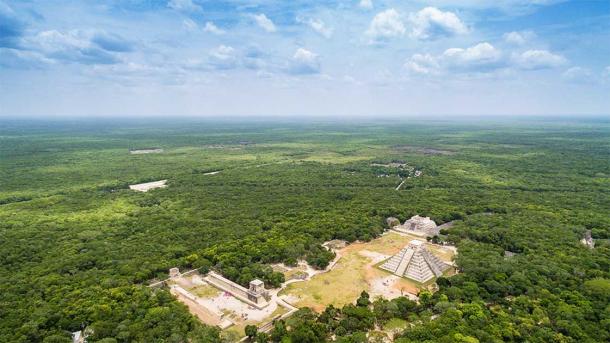
Stunning Homes of Maya Elite Revealed at Mexico’s Chichen Viejo
Archaeologists working in the northern Yucatan peninsula of Mexico have announced the discovery of a group of ancient structures near the 5th century AD Mayan city Chichen Itza. According to a Reuters press release, the buildings formed a luxury residential complex that was lived in by the “controlling elites” of the sacred city. This area has come to be known as Chichen Viejo.
La tumba y la casa de un gobernante maya salen a la luz en Chichén Itzá. Las excavaciones del INAH en la zona de Chichén Viejo documentan el enterramiento de un personaje de la élite de la dinastía de los Canules https://t.co/BlsXkX9USL
— El Cultural (@elcultural) February 13, 2023
Chichen Viejo: A First for Maya Archaeology
Attracting around 2 million visitors a year, the Chichen Itza archaeological complex is a UNESCO World Heritage Site representing one of the most popular tourist destinations in Mexico. After being founded in the 5th century AD, the city rose to regional prominence during the early Postclassic Maya period, from the 10th to 13th centuries AD.
- Chichen Itza: Ancient Maya City Built Above A Gateway to the Underworld
- Advanced Engineering Discovered at the Maya Observatory at Chichen Itza
The supremacy enjoyed by Chichen Itza during this period is reflected by the great stone monuments that were constructed by successive generations of ruling families. Although Chichen Itza was abandoned when the Spanish arrived in the 16th century, archaeologists have been excavating the site since the 19th century.
Until now, however, no signs of residential buildings had ever been identified, making the discovery at Chichen Viejo a first for Maya archaeology. Chichen Viejo is an archaeological site about a kilometer away from the famed monumental structures of Chichen Itza.

Aerial view of Chichen Itza in Mexico. The discovery of residential buildings at Chichen Viejo is a first at the site. (Dronepicr / CC BY 3.0)
Unearthing Snail, Phallus and Moon Temples
Chichen Viejo is currently under exploration by archaeologists from the National Institute of Anthropology and History (INAH) and is not open to the public. According to Reuters, archaeologist Francisco Perez Ruiz said that “until this discovery there were no known residential groups in Chichen Itza,” but this residential complex was lived in by a powerful regional ruler and his entire elite family.
In one interpretation the name Chichen Itza suggests “magicians of the water,” because the word Itza is a combination of two words: itz meaning magic and a standing for water. The word viejo means “old,” so the name of this area, Chichen Viejo, means “Old Water Magicians” referring to the earliest level of occupation at Chichen Itza.
“The study of these peripheral groups, around the central part, could tell us about other families, other groups that made up this great city,” explained INAH archaeologist Jose Osorio Leon on CNN. “There must be more residential groups that have not been explored yet,” added Leon.
La zona arqueológica de #ChichénViejo o Serie Inicial, que es uno de los 13 complejos que se encuentran alrededor del centro ceremonial de Chichén Itzá, pronto se reabrirá al visitante, sobre todo a los que lleguen a bordo del Tren Maya.
“Hay un 75% de avance en la habilitación. pic.twitter.com/fL10q87AzY— Contacto Noticias (@noticiascontact) February 7, 2023
An Ancient World of Animal and Phallus Worship
Located about 800 meters (2624 ft) south of Las Monjas de Chichén Itzá, the area known as Chichen Viejo has been under archaeological exploration since 1998. Measuring 150 meters (492 ft) north-south by 125 meters (410 ft) east-west it has eight main structures, including the Temple of the Initial Series, the Palace of the Phalluses, the House of the Snails, the Temple of the Owls, the Gallery of Monkeys and the Platform of the Turtle.
- Attention-Seeker Treks Over Forbidden Mexican Pyramid
- Chichen Itza's Shadows: Unexpected Light Shed on Ancient Maya
A 2008 study published on Pueblos Originarios de América described the Temple of the Initial Series as “the only pyramidal construction” in the group. Built in four different stages it comprises the Estructura de los Estucos, the Temple of Sacrifices, the Temple of the Atlantean Columns, and the Temple of the Initial Series itself.
Meanwhile, the largest complex in the group of structures is the Palace of the Phalluses, which includes the House of the Phalluses with its eleven vaulted rooms. The House of the Snails is characterized by a vaulted corridor in the center, aligned east to west, connecting the Patio de Los Phallos (Patio of the Penis) with the square formed by the House of the Owls, the House of the Monkeys and the Temple of the Little Heads.
El arqueólogo José Osorio León, investigador con más de 20 años de trayectoria en el @inahmx , muestra la plataforma donde encontraron una #TumbaMaya en la zona arqueológica de #ChichénViejo que este año abrirá al público. pic.twitter.com/fbCvkM5Wp8
— Contacto Noticias (@noticiascontact) February 11, 2023
Lastly, the Platform of the Turtle is a circular structure with two steps that resembles the shape of a large turtle. In the 2008 study, archaeologist Luis Martos interpreted the turtle as representing “a terrestrial and aquatic element related to the creation myth and the Orion constellation.”
Moving forward, INAH archaeologist Jose Osorio Leon has expressed the belief that the future study of residential structures will reveal secrets about the different cultures that lived at the city of Chichen Itza, one of the greatest ancient cities in the Americas.
Top image: Representational image depicting ruins unearthed at Chichen Itza. Residential buildings found at Chichen Viejo are a first for Maya archaeology. Source: Jonatan Cortes / Adobe Stock
By Ashley Cowie















